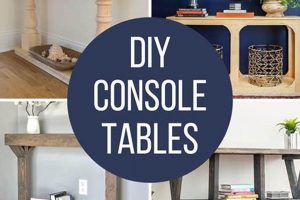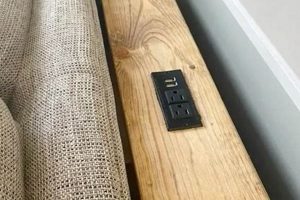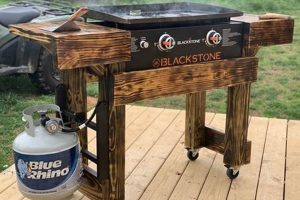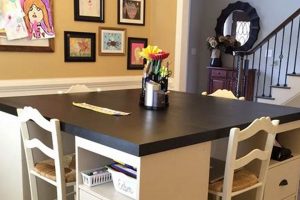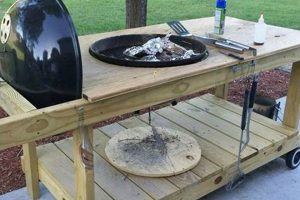The creation of compact, self-constructed furniture represents a practical approach to space optimization and personalized design. These pieces are typically built using readily available materials and basic tools, allowing individuals to tailor dimensions and aesthetics to suit specific needs and preferences. For example, a narrow surface assembled from reclaimed wood and hairpin legs can serve as a bedside unit in a small apartment.
Undertaking such projects offers several advantages, including cost savings compared to purchasing commercially manufactured items, the satisfaction of producing a functional object, and the opportunity to recycle or repurpose existing materials. Historically, the practice of crafting one’s own furnishings has been a necessity in many cultures, evolving from basic survival needs to a means of expressing individual creativity and resourcefulness. This approach fosters a connection to the physical world and promotes sustainable consumption habits.
The following sections will explore various aspects related to constructing such furnishings, covering material selection, design considerations, assembly techniques, and finishing options. The aim is to provide a comprehensive guide for those interested in creating their own customized and space-saving furniture pieces.
Construction Considerations
The following recommendations provide practical guidance for individuals embarking on the construction of compact, self-assembled furnishings. Adhering to these principles enhances the structural integrity, aesthetic appeal, and overall longevity of the finished product.
Tip 1: Material Selection: Prioritize materials based on durability, suitability for the intended application, and aesthetic preferences. Solid hardwoods, such as oak or maple, offer superior strength and resistance to wear. Engineered wood products, like plywood or MDF, provide stability and are suitable for painted finishes.
Tip 2: Accurate Measurement and Cutting: Precise measurements are paramount. Utilize a measuring tape, level, and square to ensure accurate dimensions and right angles. Employ appropriate cutting tools, such as a circular saw or jigsaw, and adhere to established safety protocols.
Tip 3: Secure Fastening Methods: Select appropriate fasteners based on the materials being joined and the anticipated load. Screws provide greater holding power than nails. Consider using wood glue in conjunction with fasteners to create a stronger and more durable bond.
Tip 4: Stable Leg Attachment: The integrity of the leg attachment is critical for stability. Employ metal brackets or mortise-and-tenon joinery to securely connect legs to the tabletop or frame. Ensure that legs are properly aligned to prevent wobbling.
Tip 5: Smooth Surface Preparation: Sand all surfaces thoroughly to remove imperfections and create a smooth, even finish. Start with a coarse grit sandpaper and gradually progress to finer grits. This step is essential for achieving a professional-looking result.
Tip 6: Protective Finish Application: Apply a protective finish to enhance durability and protect against moisture, scratches, and stains. Options include varnish, polyurethane, lacquer, and oil-based finishes. Follow the manufacturer’s instructions for application and drying times.
Tip 7: Consider Space Constraints: Before commencing construction, carefully consider the available space and desired dimensions. Mock up the proposed furnishings using cardboard or other readily available materials to verify fit and functionality.
Adherence to these guidelines will contribute to the successful fabrication of durable, aesthetically pleasing, and functional compact furnishings.
The subsequent section will address specific design considerations for optimizing space utilization and maximizing the utility of these self-assembled pieces.
1. Dimensions and Proportions
The dimensions and proportions of self-assembled, compact surfaces are paramount considerations in both design and functionality. These factors dictate not only the aesthetic appeal but also the practical utility of the finished product within a confined space.
- Space Optimization
The primary benefit of accurately calculated dimensions lies in maximizing available space. Careful measurement and planning ensure the finished surface integrates seamlessly within the intended environment, avoiding obstructions or creating a sense of overcrowding. In small apartments, for instance, a narrow bedside surface optimizes space while still serving its intended purpose.
- Ergonomic Considerations
Proportions directly influence user comfort and accessibility. The height of a work surface, for example, should align with ergonomic principles to prevent strain and promote efficient task performance. A surface that is too high or too low can lead to discomfort and reduced productivity. Similar considerations apply to the depth and width of the surface, which should accommodate the intended use case.
- Structural Stability
Dimensions and proportions play a critical role in structural integrity. Overly slender legs or an excessively large tabletop can compromise the stability of the entire structure. Careful calculation of these elements is essential to ensure the surface can safely support intended loads without risk of collapse or tipping.
- Aesthetic Harmony
Proportions significantly contribute to the visual appeal of a surface. Harmonious proportions create a sense of balance and visual coherence, enhancing the overall aesthetic impression. Conversely, disproportionate elements can create a sense of awkwardness or imbalance. Careful consideration of these aspects leads to a more pleasing and integrated design.
In conclusion, precise management of dimensions and proportions is integral to the successful design and construction of compact surfaces. These factors collectively influence space optimization, user ergonomics, structural integrity, and aesthetic harmony, ultimately determining the overall utility and desirability of the finished product.
2. Material Selection
The selection of appropriate materials is a foundational decision in the construction of any compact, self-assembled surface. This choice dictates the structural integrity, aesthetic characteristics, and overall longevity of the finished piece. Careful consideration must be given to the inherent properties of each material and its suitability for the intended application.
- Wood Type and Durability
The selection between hardwoods (e.g., oak, maple) and softwoods (e.g., pine, fir) directly impacts durability. Hardwoods offer superior resistance to wear, scratches, and dents, making them suitable for surfaces subjected to frequent use. Softwoods are more readily available and easier to work with but require additional protection. For instance, a surface crafted from reclaimed oak can withstand daily use for extended periods, while a pine surface may necessitate a protective coating to prevent damage.
- Engineered Wood Products
Engineered wood products such as plywood and MDF provide alternatives to solid wood, offering stability and cost-effectiveness. Plywood, composed of multiple layers of wood veneer, exhibits dimensional stability and resistance to warping. MDF, made from wood fibers compressed with resin, provides a smooth, uniform surface ideal for painting or veneering. The choice depends on the desired aesthetic and structural requirements of the surface; MDF is often selected for painted furniture where a perfectly smooth finish is desired.
- Reclaimed and Recycled Materials
Employing reclaimed or recycled materials presents an environmentally conscious option. Reclaimed wood, sourced from salvaged structures, adds character and reduces demand for newly harvested timber. Recycled materials, such as plastic or metal, can be repurposed to create unique and sustainable surfaces. An example includes utilizing reclaimed barn wood to construct a rustic surface, contributing to environmental conservation while adding unique visual appeal.
- Fastener Compatibility
The selected material must be compatible with the chosen fastening methods. Softwoods may require pilot holes to prevent splitting when using screws, while hardwoods may necessitate pre-drilling for secure fastening. The compatibility between the material and fasteners ensures a strong and durable connection, essential for the structural integrity of the assembled surface. Incompatible combinations can lead to weakened joints and premature failure.
In summary, the process of material selection for compact, self-assembled surfaces is a multifaceted decision that encompasses structural requirements, aesthetic preferences, environmental considerations, and compatibility with fastening methods. A judicious selection process ensures the creation of a durable, aesthetically pleasing, and functional piece that meets the specific needs of the user and the constraints of the available space. The long-term performance and visual appeal of the finished product hinge upon making informed choices during this critical stage.
3. Joint Strength
Joint strength is a critical factor in the successful construction of compact, self-assembled surfaces. The robustness of connections between components directly influences the overall stability, durability, and safety of the finished product. Compromised joint integrity can lead to premature failure, rendering the surface unusable and potentially hazardous.
- Fastener Selection and Application
The type and application of fasteners significantly impact joint strength. Screws, for example, provide greater holding power than nails, particularly when joining hardwoods. Proper screw length and diameter must be selected based on the material thickness. The use of pilot holes is crucial to prevent splitting when working with certain wood types. Incorrect fastener selection or improper application techniques can result in weakened joints susceptible to separation under stress.
- Adhesive Bonding
Adhesive bonding, often used in conjunction with mechanical fasteners, enhances joint strength by creating a continuous bond between surfaces. Wood glue, specifically designed for woodworking applications, penetrates the wood fibers and forms a strong, rigid connection. Proper surface preparation, including cleaning and clamping, is essential for optimal adhesive performance. Insufficient adhesive coverage or inadequate clamping pressure can compromise the bond strength, leading to joint failure.
- Joinery Techniques
Traditional joinery techniques, such as mortise-and-tenon or dovetail joints, offer robust mechanical connections that can withstand significant stress. These techniques require precision cutting and fitting to ensure tight, secure joints. While more complex to execute than simple butt joints, well-crafted joinery techniques provide superior strength and longevity. The selection of appropriate joinery methods depends on the design requirements and the level of skill possessed by the builder.
- Load Distribution and Support
The design of the joint must consider load distribution and support. Joints subjected to high stress concentrations require reinforcement or additional support to prevent failure. For example, legs attached to a tabletop must be securely fastened and designed to distribute the load evenly across the surface. Reinforcing elements, such as corner brackets or aprons, can be incorporated to enhance joint strength and stability. Failure to address load distribution can result in joint failure under normal operating conditions.
In conclusion, achieving adequate joint strength in compact, self-assembled surfaces requires careful consideration of fastener selection, adhesive bonding, joinery techniques, and load distribution. A well-executed joint ensures the stability, durability, and safety of the finished product, contributing to its long-term functionality and aesthetic appeal.
4. Surface Finishing
Surface finishing represents a crucial phase in the construction of a compact, self-assembled surface, significantly influencing its aesthetic appeal, durability, and resistance to environmental factors. This process encompasses a range of techniques and materials applied to the completed structure to protect, enhance, and customize its final appearance. The choice of finishing method should align with the intended use, material composition, and desired aesthetic outcome of the surface.
- Protective Coatings
Protective coatings, such as varnishes, polyurethanes, and lacquers, form a barrier against moisture, scratches, and stains. These finishes are typically applied in multiple layers to ensure adequate protection. The selection of a specific coating depends on the material of the surface and the level of protection required. For instance, a polyurethane finish applied to a wooden surface protects it from water damage in environments with high humidity, extending its lifespan.
- Aesthetic Enhancements
Surface finishes can enhance the aesthetic qualities of the surface through the application of stains, paints, or dyes. Stains accentuate the natural grain of wood, while paints provide a uniform color and can conceal imperfections. The choice of color and finish (e.g., matte, gloss, satin) impacts the overall visual appeal and its integration into a specific interior design scheme. Applying a dark stain to a wooden surface can create a sense of warmth and sophistication, complementing a traditional dcor.
- Preparation Techniques
Proper surface preparation is essential for achieving a high-quality finish. This involves sanding to create a smooth, even surface, removing dust and debris, and applying a primer or sealer to improve adhesion. Failure to adequately prepare the surface can result in uneven coverage, peeling, or bubbling. Thorough sanding is crucial before applying any finish to ensure proper adhesion and a professional-looking result.
- Application Methods
The application method impacts the uniformity and smoothness of the finish. Options include brushing, spraying, and wiping. Spraying provides the most consistent coverage but requires specialized equipment and ventilation. Brushing is a more accessible method but requires careful technique to avoid brush marks. The choice of application method depends on the type of finish and the available resources. A spray-applied lacquer finish on a small surface can achieve a smooth, even appearance with minimal effort.
In conclusion, surface finishing plays a pivotal role in the creation of a compact, self-assembled surface, influencing not only its visual appeal but also its resistance to wear and tear. By carefully selecting the appropriate materials, preparation techniques, and application methods, individuals can create a durable and aesthetically pleasing surface that complements its intended environment.
5. Leg Stability
Leg stability constitutes a fundamental requirement for the structural integrity and functional utility of any self-constructed, compact surface. Inadequate leg stability compromises the surface’s ability to support intended loads, potentially leading to instability, damage, or even collapse. Therefore, meticulous attention to leg design and attachment is paramount.
- Material Selection for Leg Components
The choice of material for the legs directly influences their load-bearing capacity and resistance to deformation. Hardwoods, such as oak or maple, offer superior strength compared to softwoods like pine. Metal legs, typically steel or aluminum, provide enhanced stability for heavier loads or surfaces with larger dimensions. The selection process must consider the anticipated weight and distribution of objects placed on the surface, ensuring the chosen material possesses sufficient strength and rigidity.
- Attachment Methods and Joint Integrity
The method used to attach the legs to the tabletop or frame significantly impacts the overall stability of the structure. Secure attachment techniques, such as mortise-and-tenon joints or metal brackets with screws, provide greater resistance to lateral forces compared to simple screw attachments. The integrity of the joints must be maintained throughout the life of the surface. Regular inspection and tightening of screws or reinforcement of joints may be necessary to prevent loosening and maintain stability.
- Leg Geometry and Placement
The geometry and placement of the legs contribute significantly to the overall stability of the surface. Angled legs, for instance, provide increased resistance to tipping compared to straight, vertical legs. The legs must be positioned to distribute the load evenly across the surface. Unevenly spaced or improperly aligned legs can create stress concentrations, leading to instability and potential failure. Careful consideration of leg placement during the design and construction phases is essential.
- Load Distribution and Weight Capacity
The design must account for the anticipated load distribution and weight capacity of the surface. Overloading can compromise the integrity of the legs and joints, leading to instability and potential collapse. Reinforcement elements, such as aprons or stretchers, can be incorporated to distribute the load more evenly across the legs and frame. Clear communication of the surface’s weight capacity is crucial to prevent misuse and ensure its safe operation.
These interconnected aspects of leg stability determine the functional lifespan and safety of the DIY surface. Careful planning, appropriate material selection, robust attachment methods, thoughtful leg geometry, and considerations of load distribution are essential elements in constructing a stable and reliable piece. Neglecting any of these factors can compromise the surface’s integrity and render it unsuitable for its intended purpose.
6. Design Aesthetics
Design aesthetics, in the context of self-constructed compact surfaces, represent the integration of visual appeal with functional utility. The careful consideration of form, color, and texture enhances the overall user experience, transforming a utilitarian object into a visually pleasing element within a defined space.
- Harmonious Proportions and Spatial Integration
Proportional relationships dictate how the surface integrates within its environment. A surface with balanced dimensions will enhance visual harmony, whereas disproportionate elements can disrupt spatial coherence. For example, a slender surface with elegant lines might complement a minimalist aesthetic, while a bulky surface might be more appropriate for a rustic setting. The careful selection of dimensions and proportions directly impacts the overall visual impact of the piece.
- Material Texture and Color Palette
The tactile and visual qualities of materials contribute significantly to the aesthetic character. Wood grain patterns, metal finishes, and fabric textures evoke different sensory responses and influence the overall perception of quality and craftsmanship. A carefully curated color palette, considering both the surface itself and its surroundings, can create visual harmony or contrast to achieve a desired effect. Reclaimed wood with a distressed finish, for instance, introduces a sense of history and texture, while a brightly painted surface injects vibrancy and personality.
- Surface Detailing and Decorative Elements
The inclusion of surface details, such as carved patterns, inlaid designs, or decorative hardware, elevates the aesthetic sophistication of the piece. These elements can range from subtle accents to bold statements, reflecting personal style and craftsmanship. A simple surface enhanced with hand-painted designs, for example, transforms a basic piece into a personalized work of art, adding a unique touch to the surrounding environment.
- Functional Form and Visual Expression
Design aesthetics are not solely focused on visual appeal but also on how form follows function. The shape and configuration of the surface should align with its intended use while simultaneously expressing a distinct visual identity. A surface designed to serve as a reading stand might incorporate a tilted plane and integrated book support, seamlessly blending functionality with aesthetic appeal. The integration of form and function results in a piece that is both visually pleasing and practically effective.
These aesthetic elements, when thoughtfully combined, transform a utilitarian self-constructed surface into an integrated and visually compelling component of the surrounding environment. The careful selection and execution of design aesthetics contribute to both the functional and emotional value of the finished piece, reflecting personal style and enhancing the user experience.
Frequently Asked Questions
The following questions address common inquiries regarding the design, construction, and maintenance of compact, self-assembled surfaces. The responses provide information to assist individuals in creating durable and functional pieces.
Question 1: What is the optimal tabletop thickness for a compact surface designed to support moderate weight?
Tabletop thickness is contingent upon the material used and the anticipated load. For solid hardwoods, a minimum thickness of 0.75 inches is generally recommended. Engineered wood products, such as plywood, may require a greater thickness to achieve comparable strength. Reinforcement measures, such as aprons, can enhance the load-bearing capacity of thinner tabletops.
Question 2: What are the most effective methods for preventing wood warping in self-assembled surfaces?
Wood warping can be mitigated through proper material selection and construction techniques. Utilizing kiln-dried lumber reduces moisture content and minimizes the risk of warping. Sealing all surfaces with a moisture-resistant finish further protects the wood from environmental factors. Implementing joinery techniques that restrict wood movement, such as mortise-and-tenon joints, enhances dimensional stability.
Question 3: How can a novice ensure accurate measurements and cuts when constructing a surface?
Accurate measurements are paramount for successful construction. Utilizing a quality measuring tape, level, and square is essential. Double-checking all measurements before cutting is recommended. Employing a cutting guide or track saw can improve the precision of cuts. Practicing on scrap material prior to cutting the final components minimizes the risk of errors.
Question 4: What type of fasteners are most suitable for joining wood components in self-assembled surfaces?
Screws generally provide superior holding power compared to nails. The appropriate screw length should be selected based on the material thickness. Pre-drilling pilot holes is recommended to prevent splitting, particularly when working with hardwoods. Wood glue, applied in conjunction with screws, enhances joint strength and durability. The selection of fastener type depends on the specific joint configuration and the anticipated stress on the connection.
Question 5: How can a durable and aesthetically pleasing finish be achieved on a self-assembled surface?
Proper surface preparation is essential for a high-quality finish. Thorough sanding to remove imperfections and create a smooth surface is recommended. Applying a primer or sealer improves adhesion and prevents the finish from being absorbed unevenly. Multiple thin coats of finish provide a more durable and even result than a single thick coat. Allowing adequate drying time between coats is crucial for optimal performance.
Question 6: What safety precautions should be observed when constructing self-assembled surfaces?
Eye protection should be worn at all times when cutting or sanding materials. A dust mask or respirator is recommended to prevent inhalation of airborne particles. Power tools should be operated in accordance with the manufacturer’s instructions. A well-ventilated workspace minimizes exposure to fumes from finishes and adhesives. Secure workholding devices, such as clamps or vises, prevent movement and reduce the risk of accidents.
Adherence to these guidelines will assist individuals in constructing durable, functional, and aesthetically pleasing compact surfaces. Careful planning and attention to detail are critical for successful outcomes.
The subsequent section will address project ideas for “diy small table”
Conclusion
The preceding sections have explored various facets of compact, self-constructed tables, emphasizing design considerations, material selection, construction techniques, and finishing options. Attention to these details is paramount for achieving structural integrity, aesthetic appeal, and functional utility. The information presented serves as a guide for individuals seeking to create customized furnishings tailored to their specific needs and spatial constraints.
Effective implementation of the principles outlined herein will result in durable, aesthetically pleasing, and space-saving surfaces. Further exploration and application of these techniques offer opportunities for continued innovation and refinement in the realm of compact furniture design. This knowledge empowers individuals to create functional art that reflects resourcefulness and promotes sustainable practices within the built environment.



